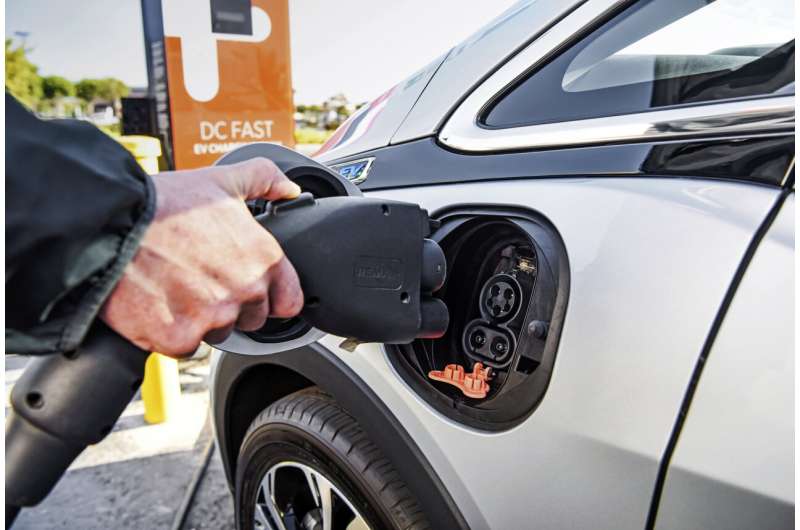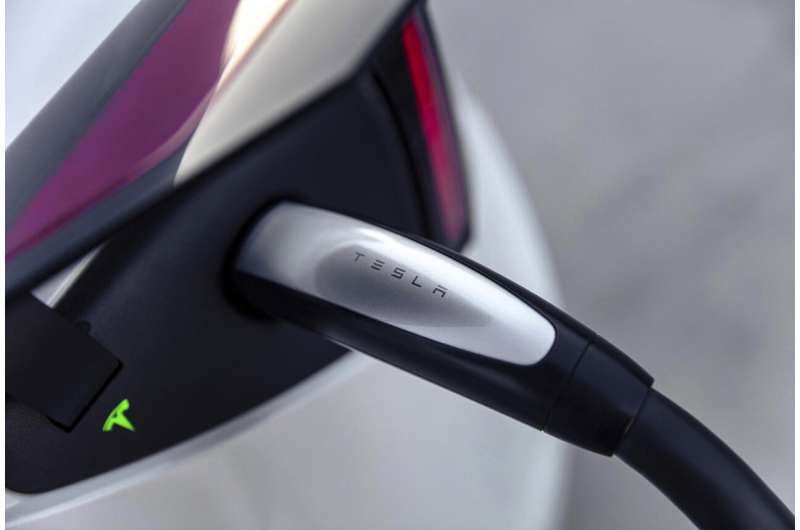This article has been reviewed according to Science X's editorial process and policies. Editors have highlighted the following attributes while ensuring the content's credibility:
fact-checked
reputable news agency
proofread
Tesla wins the EV charge plug format war

You're probably familiar with previous technology format wars, whether it be VHS versus Betamax or Blu-ray versus HD DVD. Now another has quickly brewed in the way people plug in and charge their electric vehicles. It's a battle of CCS versus NACS, and the winning format has a familiar backer: Tesla. Edmunds' experts break down what EV owners need to know about the format changes.
THE COMPETING FORMATS
The majority of electric vehicles, or EVs, currently have one of two types of plug styles to connect to public fast-charging stations. The first is called the Combined Charging System, or CCS. It's used on nearly all EVs except Tesla vehicles. The other is the North American Charging Standard, or NACS. All Tesla vehicles have this style plug.
These two formats currently coexist independently without much issue. If you own a Tesla, you'll typically stop at a Tesla Supercharger station that has NACS. For other EVs, you'll use third-party stations with the CCS-style plug.
But in May, Ford made a shocking announcement: It made a deal with Tesla to switch its future EVs to Tesla's NACS plug in lieu of the CCS plug. The switch to NACS means owners of these Ford EVs will be able to charge at Tesla stations. Soon after, many other automakers followed suit.
THE BRANDS THAT HAVE SWITCHED
At the time of writing, companies that have agreed to switch to NACS include Ford Motor Co., Mercedes-Benz, General Motors, Nissan, Rivian, Volvo and Polestar. A number of other automakers such as BMW, Volkswagen and Hyundai are in discussions with Tesla but have not yet confirmed a switch to NACS.
THE DIFFERENCES BETWEEN CCS AND NACS
While both CCS and NACS plugs perform the same basic function—safely deliver electricity into an EV's onboard battery pack and provide added driving range—there are some notable differences. In terms of appearance alone, the NACS plug is noticeably slimmer and less cumbersome. As an added benefit, it allows for a smaller charge point to be incorporated into an EV's design.
In terms of how they operate, CCS maintains a slight lead because it's capable of recharging at higher outputs. While Supercharger charge points currently have a maximum output of 250 kW, a small but growing number of CCS fast chargers can reach 350-kW levels of recharging.

NACS PROMISES A BETTER CHARGING EXPERIENCE
A primary motivating factor has been the current spotty and inconsistent third-party charging experience, with numerous brands, logins and apps. Meanwhile, Tesla's Supercharger stations are far and away the largest single network of DC fast chargers. Having this scale of recharging infrastructure, along with a single-use plug and billing account to streamline and simplify the charging process, is vital to making EVs an easier sell to skeptical car shoppers.
The scale of the Supercharger network didn't escape the attention of the federal government either. It has roughly $7.5 billion allocated toward EV adoption and boosting charging infrastructure. As part of this program, which includes federal subsidies for charging stations adaptable to a combination of CCS and NACS plugs, Tesla has agreed to open Supercharger stations to non-Tesla vehicles. Other major charging networks, such as Electrify America and ChargePoint, are planning to include both plug standards.
EXPECT NACS ON MOST EVS BY 2025
The first non-Tesla vehicles to feature an integrated NACS plug will debut sometime in 2025, according to Ford, GM, Mercedes-Benz and other automakers embracing the new standard. Due to the complexities of revising a power port at scale, you will likely see the change occur in either all-new vehicles or those receiving a major refresh. While this all points to a major coup for Tesla and its NACS plug, owners of an EV with a CCS plug aren't being left behind.
EXISTING VEHICLES WITH A CCS PLUG
Current owners of an EV with a CCS plug might wonder if that format will become obsolete. Not anytime soon. There will still be plenty of charging stations with CCS. Additionally, an adapter will be available next year that will allow vehicles with CCS plugs to connect at a NACS charge station. It's also important to remember that these format changes mostly relate to drivers taking road trips or those who don't have a way to charge at home.
EDMUNDS SAYS,
Where and how you recharge an EV look to get a whole lot simpler and more convenient over the next few years. More charging stations and less confusion about which plugs are compatible are smart ways to boost the adoption and sales of EVs.
© 2023 The Associated Press. All rights reserved. This material may not be published, broadcast, rewritten or redistributed without permission.


















